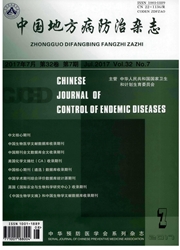

 中文摘要:
中文摘要:
目的通过实验了解碘摄入水平对哺乳期大鼠碘营养及甲状腺功能的影响以及是否存在保护子代免受碘缺乏及碘过量危害的机制。方法选择体重80~100 g的雌性Wistar大鼠96只,按体重分层后,再随机分为6组。饲养3个月后先测定尿碘,然后将前5组雌鼠与雄鼠合笼交配,在其产后5、10 d时,每组每批分别处死8只大鼠及其子鼠,取大鼠的血清和子鼠胃里的乳汁。第6组除不与雄鼠交配外,其他处理同前5组。测定大鼠尿碘、血清碘、血清甲状腺激素T3、T4水平及子鼠胃里乳汁碘水平。结果 (1)低碘组大鼠的尿碘、血清碘水平低于对照组,而高碘组、未孕对照组大鼠的尿碘、血清碘水平高于对照组,差异均有统计学意义(P〈0.05);(2)低碘组乳汁碘水平明显低于对照组,而高碘组明显高于对照组;另外,低碘1组乳汁碘水平明显高于低碘2组,差异有统计学意义(P〈0.01);(3)低碘组大鼠T3、T4水平均低于对照组,且T3/T4水平明显高于对照组;高碘组大鼠T3、T3/T4水平低于对照组,T4水平高于对照组,差异均有统计学意义(P〈0.01);(4)各组产后5 d和10 d的数据比较差异无统计学意义。结论不同碘摄入水平导致哺乳期大鼠体内碘营养水平及甲状腺功能发生了改变,且大鼠能够通过哺乳调节对子代的碘供应,以尽量减轻低碘或高碘对子代带来的危害。
 英文摘要:
英文摘要:
Objective To understand the effect of iodine intake level on iodine nutrition and thyroid function of lactating rats and the protective mechanism that can protect the offsprings from iodine deficiency or iodine excess by observing the changes of urinary iodine,serum iodine,milk iodine and the level of thyroid hormone of lactating rats,who were in different iodine intake levels.Methods 96 Wistar female rats,who weighed about 80 to 100 grams,were randomly divided into six groups according to their body weights.Each group had 16 female rats.Body weight was weighed weekly and urinary iodine was determined after feeding for 3 months,then mated and had offsprings.Last,eight female rats and their offsprings were sacrificed each batch after postpartum of 5 days and 10 days.Serum of female rats and milk of child rats in stomach were taken.Group 6 was not mated with the male,the other dealings were the same as pre-5 groups.The urine iodine,serum iodine,T3,T4 levels of serum thyroid hormone in rats and milk iodine in offspring's stomach were determined.Results(1)The means of urine iodine and serum iodine of low-iodine group were lower than that of control group,and the means of high-iodine group and control group of no pregnant were higher than that of control group.The differences were statistically significant(P0.05);(2)The levels of milk iodine in low-iodine groups were significantly lower than that of control group,while the high-iodine groups were significantly higher than that.In addition,the milk iodine level in low-iodine group 1 was significantly higher than that in the low-iodine group 2.The differences were statistically significant(P0.01);(3)The levels of T3,T4 in low-iodine groups were reduced compared with that of control group,and T3/T4 was higher.The levels of T3,T3/T4 in high-iodine groups were lower than control group,but the level of T4 were higher.The differences were statistically significant(P0.01);(4)There were no statistic differences between each group of postpartum of
 同期刊论文项目
同期刊论文项目
 同项目期刊论文
同项目期刊论文
 Geographical distribution of drinking-water with high iodine level and association between high iodi
Geographical distribution of drinking-water with high iodine level and association between high iodi 期刊信息
期刊信息
